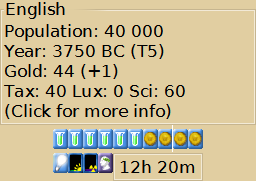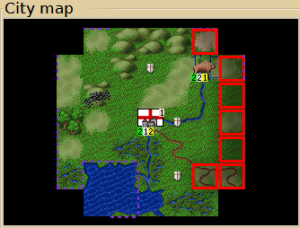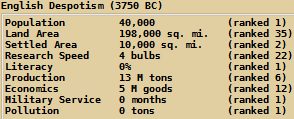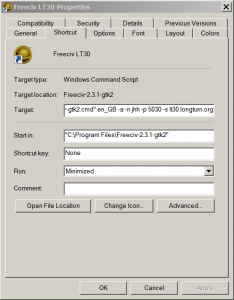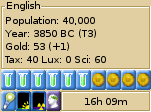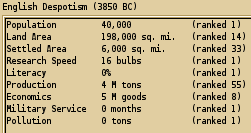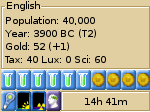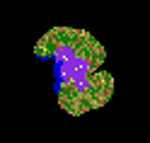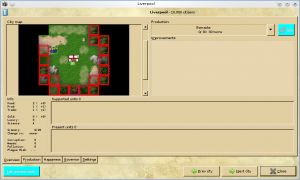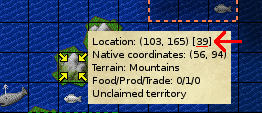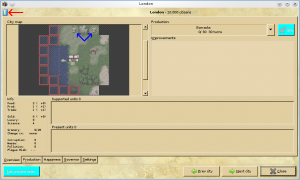It’s time for the 5th turn of LT30.
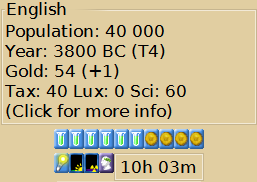
As I’ve updated yesterday’s journal later that day, I made my first contacts to neighbours. I’ve saw Aleut, Grenadian and Finland. I’m sure I’ll see many more upcoming turns. (Two of them are players I’ve played with at freeciv.fi.)
I already talked with some of them about collaborations and possible tech trading in the future. It’s good to start building trust with your co-players as soon as possible. In the end it’s all about trust in these multiuser games with human players.
I’ll soon have to start planning how to design my borders. That’s going to be harder because of the extended movement amounts in Longturn.org. I’ll have to design again how to secure my borders well enough.
It’s only one turn two turns until I’ll have Pottery and I can start building Granaries and Workers. Because I only need 8 bulbs more to get full 56 bulbs for Pottery I can reduce scientists in two or four of my cities — and still get it in 2 turns.
It’s time to check my cities again. It’s easy to forget something without regular checking.
While playing test games for LT30 I decided to build my cities as fast as I can on at least 2 food squares that give equal balance of shields and trade.
I’m not sure now if that was the best option. I had plenty of tiles I could have got 3 food out with the same amount of shields like Plains (Wheat). Those would have been much better as city centers.
Westminster
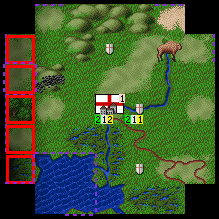
Westminster — my first city — I built on Plains/River (2-1-2) and there’s one Plains/River (Buffalo) (1-2-1) near where I am building irrigation now — when finished it’s 2-2-1.
In Despotism government I cannot get 3 food from any of these tiles here so there’s no instant need to irrigate any of those 2 food tiles. That’s why I am directing my worker’s resource to irrigate the Buffalo instead.
I’ve got 4 shields in stock out of 40 shields for Granary now. I’m getting 3 shields/turn more but once I change to Buffalo next turn, it’s 5 shields/turn with +75% bonus because it’s my capital. I’ll have Granary built on T11-T12 — in seven or eight turns — early before my city grows to 2.
It takes 10 turns to grow to size 2 and after that only about 5 turns between growing because with Granary I only need 10 food to grow from 1 to 2 again after building Settlers.
London, Birmingham and Liverpool
Rest of my cities are pretty much the same. Built near 2 food squares with some special resources and growing to size 2 some time next 10-12 turns. I’ll maybe writing detailed introductions to them sometime near future.
Research
I ended science rush this turn. I’ve got 48 bulbs of 56 required for Pottery and it’s going to take two turns to finish now. I should’ve stopped it sooner since I don’t actually need Pottery before T11-T12.
Defence Preparations
I’m building Warriors from some of my cities now because I have some borderlands I’m not satisfied yet. However don’t worry I’m really not going to be offensive — unless provoked — and I’ll be writing about that in more detail soon both here and in our private conversations.
Warriors or Workers are also useful because their vision makes citizens in cities able to use more tiles near the city borders.
I truly believe in a game style that makes co-existance possible and thrives the success for all nations — a win-win style for all the parties. I know that’s not how things have been usually at Longturn.org and it’s going to make this game really interesting. I don’t think warfare is always useless but I believe most times co-working is much more productive.
Wolfram Alpha is a really great tool for example if you need to count how much a unit costs the next turn — after you have only 5 shields left — to build Warrior of 10 shields.
You can check the formula from Freeciv Math page and use it almost as it’s there. Just write “T=5, X = ceil(2T + (T^2)/20)” in WolframAlpha — cost is about 12 gold.
However please notice that changing a building to a unit is going to reduce the shield stock by half.

